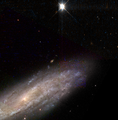NGC 2770
| Galaxie NGC 2770 | |
|---|---|
(c) ESA/Hubble, CC BY 4.0 | |
| Aufnahme des Spiralgalaxie NGC 2770 mithilfe der Wide Field Camera 3 des Hubble-weltraumteleskops | |
| AladinLite | |
| Sternbild | Luchs |
| Position Äquinoktium: J2000.0, Epoche: J2000.0 | |
| Rektaszension | 09h 09m 33,7s[1] |
| Deklination | +33° 07′ 25″[1] |
| Erscheinungsbild | |
| Morphologischer Typ | SA(s)c[1] |
| Helligkeit (visuell) | 12,0 mag[2] |
| Helligkeit (B-Band) | 12,7 mag[2] |
| Winkelausdehnung | 3,7′ × 1,1′[2] |
| Positionswinkel | 148°[2] |
| Flächenhelligkeit | 13,4 mag/arcmin²[2] |
| Physikalische Daten | |
| Zugehörigkeit | LDCE 616[1] |
| Rotverschiebung | 0,006494 ± 0,000005[1] |
| Radialgeschwindigkeit | (1947 ± 1) km/s[1] |
| Hubbledistanz H0 = 73 km/(s • Mpc) | (85 ± 6) · 106 Lj (26,2 ± 1,8) Mpc [1] |
| Durchmesser | 90.000 Lj |
| Geschichte | |
| Entdeckung | Wilhelm Herschel |
| Entdeckungsdatum | 7. Dezember 1785 |
| Katalogbezeichnungen | |
| NGC 2770 • UGC 4806 • PGC 25806 • CGCG 180-047 • MCG +06-20-038 • IRAS 09065+3319 • KUG 0906+333B • 2MASX J09093362+3307242 • GC 1768 • H II 490 • h 562 • Holm 111A • | |
NGC 2770 ist eine Spiralgalaxie vom Typ Sc und liegt im Sternbild Luchs, die schätzungsweise 85 Millionen Lichtjahre von der Milchstraße entfernt ist. Westlich von NGC 2770 liegt das Galaxienpaar NGC 2770A (ÜGC 82318) mit einer visuellen Helligkeit von 15,2 mag.
Das Objekt wurde am 17. März 1790 von dem deutsch-britischen Astronomen William Herschel mit einem 48-cm-Teleskop entdeckt.[3]
Am 9. Januar 2008 beobachtete Satellit Swift in NGC 2770 durch Zufall (er beobachtete gerade die Reste der Supernova SN 2007uy, welche am 31. Dezember 2007 von Yoji Hirose in der Galaxie entdeckt wurde) die gerade neu entstehende Supernovaexplosion SN 2008D. Er verzeichnete dabei einen fünfminütigen Ausbruch von Röntgenstrahlung mit einer Gesamtenergie von 1039 Joule, was etwa einem Hunderttausendstel der Explosionsenergie einer Supernova entspricht. Durch diese Entdeckung war es möglich die Supernova in ihrer Entwicklung zu beobachten und die Supernovatheorien zu überprüfen.[4] In NGC 2770 wurde auch die Supernova SN 1999eh beobachtet.[5]
- Aufnahmen von NGC 2770 mithilfe des Hubble-Weltraumteleskops zur Untersuchung der Supernova SN 2008D
- Aufnahme von NGC 2770 mit den Supernovae SN 2007uy und SN 2008D, durchgeführt im European Southern Observatory
Weblinks
- SIMBAD Astronomical Database
- Imposter or the Real Deal? (engl.)
- ESO Press Release 2008/23 The Quiet Explosion
Einzelnachweise
- ↑ a b c d e NASA/IPAC EXTRAGALACTIC DATABASE
- ↑ a b c d e SEDS: NGC 2770
- ↑ Seligman
- ↑ Supernova-Fabrik NGC 2770 – Astronomy Picture of the Day vom 18. Januar 2008.
- ↑ Simbad Supernova
Auf dieser Seite verwendete Medien
(c) ESA/Hubble, CC BY 4.0
Imposter or the Real Deal? Imposter or the Real Deal?
This Picture of the Week, taken by the NASA/ESA Hubble Space Telescope, shows a close-up view of a galaxy named NGC 2770. NGC 2770 is intriguing, as over time it has hosted four different observed supernovae (not visible here).
Supernovae form in a few different ways, but always involve a dying star. These stars become unbalanced, lose control, and explode violently, briefly shining as brightly as an entire galaxy before slowly fading away.
One of the four supernovae observed within this galaxy, SN 2015bh, is especially interesting. This particular supernova initially had its identity called into question. When it was first discovered in 2015, astronomers classified SN 2015bh as a supernova imposter, believing it to be not an exploding star but simply an unpredictable outburst from a massive star in its final phase of life. Thankfully, astronomers eventually discovered the truth and the object was given its correct classification as a Type II supernova, resulting from the death of a star between eight and 50 times the mass of the Sun.
Credit:
ESA/Hubble & NASA, A. Filippenko
Coordinates Position (RA): 9 9 34.38 Position (Dec): 33° 7' 19.30" Field of view: 2.65 x 2.47 arcminutes Orientation: North is 16.1° right of vertical
Colours & filters Band Wavelength Telescope Optical V 555 nm Hubble Space Telescope WFC3 Optical B 438 nm Hubble Space Telescope WFC3 Optical r 625 nm Hubble Space Telescope WFC3 Optical I 814 nm Hubble Space Telescope WFC3.
Autor/Urheber: Credit: ESO, Lizenz: CC BY 3.0
The Quiet Explosion
The Quiet Explosion
Click to Enlarge
The spiral galaxy NGC 2770 and its two supernovae as observed at the Asiago Observatory. The image was obtained on 12 January 2008 and shows the then fading SN 2007uy and the newly discovered SN 2008D.
Credit:
ESO
.Autor/Urheber: Fabian RRRR, Lizenz: CC BY-SA 3.0
Color rendering is done by by Aladin-software (2000A&AS..143...33B.)





